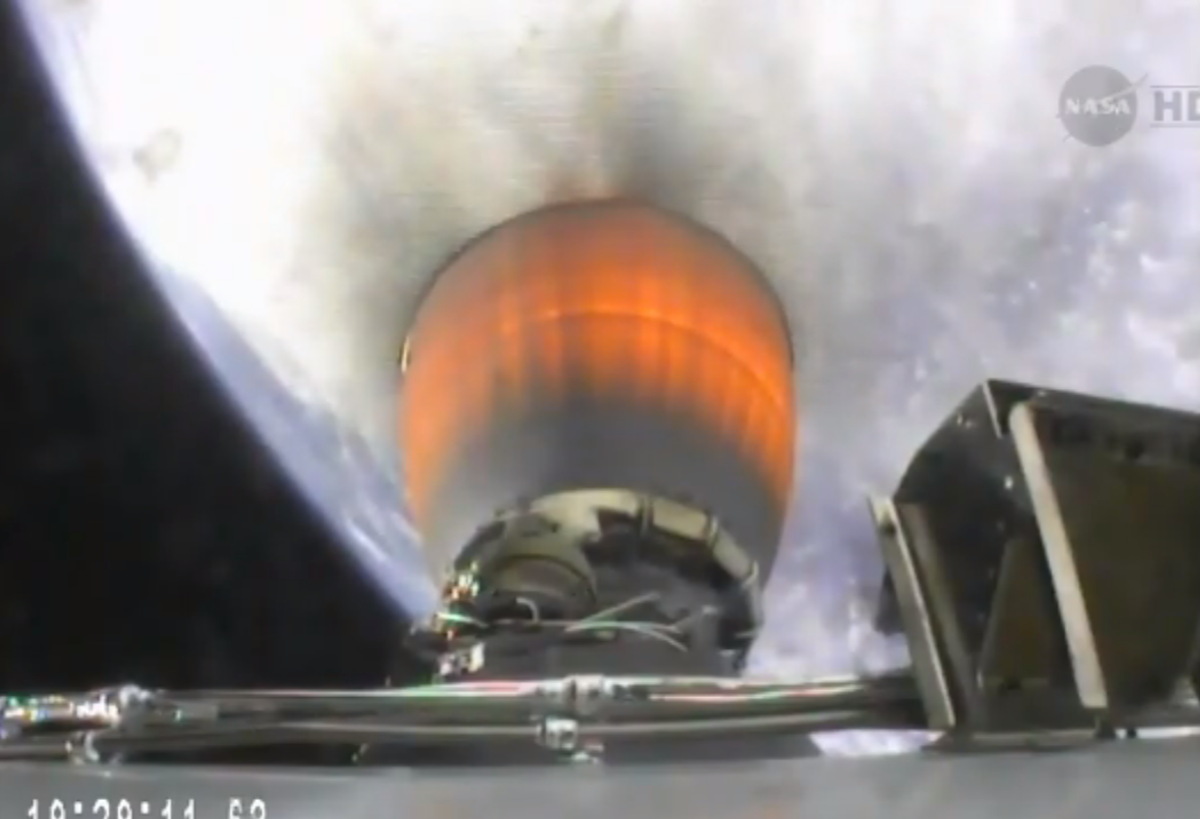
Skywatchers across parts of the United States and southern Canada will get an opportunity to watch as the private spaceflight company SpaceX's Dragon capsule "chases" the International Space Station across the sky.
Both the unmanned Dragon spacecraft and the space station will be visible as separate entities, appearing as "stars" sailing across the evening’s twilight sky. Dragon is expected to arrive at the space station on Easter Sunday (April 20) at around 7:14 a.m. EDT (1114 GMT), meaning that by Sunday evening, both will appear as a singular bright moving "star." You can watch Dragon arrive at the station live on Space.com via NASA TV Sunday.
The station makes one full circuit of the Earth every 90 minutes. Initially, SpaceX's Dragon will trail the orbiting outpost by about 25 minutes. But by Saturday evening, that gap will have diminished to only about 1 or 2 minutes. That means it might be possible to see both space vehicles in the sky at the same time. The station would appear first, followed a minute or two later by the Dragon capsule traveling along basically the same path. [See photos of SpaceX's 3rd Dragon mission to the station]
Brightness?
Most satellites become visible only when they are in sunlight and the observer is in deep twilight or darkness. This usually means they can be spotted shortly after dusk or before dawn. Because of its size and the configuration of highly reflective solar panels, the station is now, by far, the brightest man-made object currently in orbit around Earth.
On favorable passes, the station is as brilliant as magnitude negative 5 in brightness, which rivals Venus and is more than 25 times brighter than Sirius, the brightest star in the night sky. Some skywatchers have even caught a glimpse of the station just prior to sunset or shortly after sunrise. And as a bonus, sunlight glinting directly off the solar panels can sometimes make the space laboratory appear to briefly flare to superbrilliance.
The Dragon capsule, on the other hand, is much smaller than the station, measuring about 14.4 feet (4.4 meters) tall and 12 feet (3.66 m) in diameter. The trunk is about 9.2 feet (2.8 m) tall and 12 feet wide, but with its solar panels fully extended, the vehicle is about 54 feet (16.5 m) wide.
Get the Space.com Newsletter
Breaking space news, the latest updates on rocket launches, skywatching events and more!
Consequently, in terms of overall brightness, Dragon will appear much dimmer than the station. It may appear roughly as bright as a third-magnitude star (i.e., moderately bright). Megrez, the star that joins the handle with the bowl of the Big Dipper, is a third-magnitude star. That would make the Dragon capsule about 1,500 times dimmer than the station.
To better gauge the difference in brightness, check out this video of the space station closely accompanied by the Dragon capsule as they glided very closely together across the sky in May 2012: The movie was captured by Kevin Fetter, a well-known amateur satellite observer based in Canada.
When and where to look
So, what is the viewing schedule for your hometown? You can easily find out by visiting one of these three websites:
Each will ask for your ZIP code or city and will return a list of suggested spotting times. Predictions computed a few days ahead of time are usually accurate within a few minutes. However, they can change due to the slow decay of the space station's orbit and periodic reboosts to higher altitudes. Check frequently for updates.
Another website provides real-time satellite tracking at any given moment: http://www.n2yo.com/?s=25544.
Editor's Note: If you snap an amazing photo of Dragon's launch or spot the spacecraft in orbit and would like to share the picture for a story or gallery, send images and details (including viewing location) to managing editor Tariq Malik at tmalik@space.com.
Joe Rao serves as an instructor and guest lecturer at New York's Hayden Planetarium. He writes about astronomy for Natural History magazine, the Farmer's Almanac and other publications, and he is also an on-camera meteorologist for News 12 Westchester, N.Y.Follow us @Spacedotcom, Facebook and Google+. Original article on Space.com.
Join our Space Forums to keep talking space on the latest missions, night sky and more! And if you have a news tip, correction or comment, let us know at: community@space.com.

Joe Rao is Space.com's skywatching columnist, as well as a veteran meteorologist and eclipse chaser who also serves as an instructor and guest lecturer at New York's Hayden Planetarium. He writes about astronomy for Natural History magazine, Sky & Telescope and other publications. Joe is an 8-time Emmy-nominated meteorologist who served the Putnam Valley region of New York for over 21 years. You can find him on Twitter and YouTube tracking lunar and solar eclipses, meteor showers and more. To find out Joe's latest project, visit him on Twitter.









